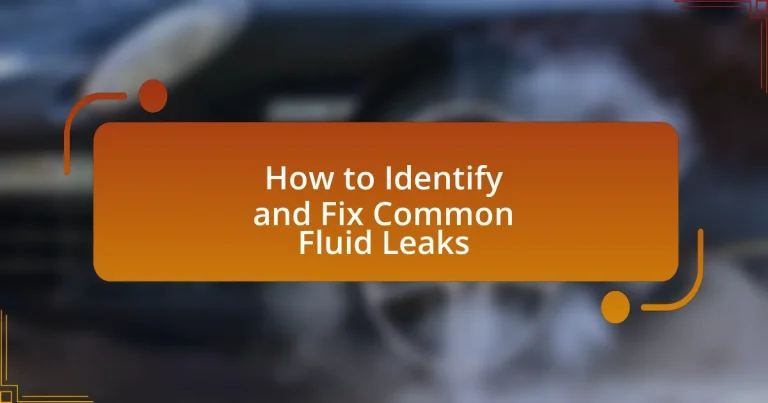The article focuses on identifying and fixing common fluid leaks in vehicles and equipment, detailing various types of leaks such as engine oil, coolant, transmission fluid, brake fluid, and power steering fluid. It outlines the signs and symptoms of fluid leaks, including visible puddles, fluid level drops, and unusual odors or sounds. The article emphasizes the importance of early detection to prevent extensive damage and safety hazards, and it provides methods for leak identification, including visual inspections and diagnostic tools. Additionally, it discusses repair techniques, the materials needed, and when to seek professional help, along with best practices for preventing future leaks.

What are Common Fluid Leaks?
Common fluid leaks include engine oil leaks, coolant leaks, transmission fluid leaks, brake fluid leaks, and power steering fluid leaks. Engine oil leaks often occur due to worn gaskets or seals, while coolant leaks can result from damaged hoses or radiator issues. Transmission fluid leaks typically arise from faulty seals or pan gaskets. Brake fluid leaks are critical as they can lead to brake failure, often caused by worn brake lines or master cylinders. Power steering fluid leaks usually stem from damaged hoses or the steering rack. Each type of leak can significantly impact vehicle performance and safety, making timely identification and repair essential.
How can you recognize the signs of fluid leaks?
You can recognize the signs of fluid leaks by observing visible puddles or stains under vehicles or equipment, noticing a decrease in fluid levels in reservoirs, and detecting unusual smells or sounds. These indicators suggest that fluid is escaping from a system. For example, oil leaks often leave dark, greasy spots, while coolant leaks may produce a sweet smell and a green or orange fluid. Additionally, warning lights on dashboards can signal low fluid levels, confirming the presence of a leak.
What are the typical symptoms indicating a fluid leak?
Typical symptoms indicating a fluid leak include visible puddles or spots of fluid under a vehicle, a decrease in fluid levels in reservoirs, and unusual noises such as hissing or dripping. These symptoms can be observed when a vehicle is parked or during operation, indicating that a leak may be present. For instance, oil leaks often leave dark brown or black spots, while coolant leaks may appear green or orange, depending on the type of fluid. Additionally, warning lights on the dashboard, such as the oil pressure or coolant temperature lights, can signal a fluid leak, as they indicate that fluid levels are critically low.
How do different fluids manifest leaks in vehicles?
Different fluids in vehicles manifest leaks through distinct characteristics and locations. Engine oil leaks typically appear as dark, viscous spots under the engine, often indicating a worn gasket or seal. Transmission fluid leaks are usually red or brown and can be found pooling under the transmission, signaling potential issues with seals or the transmission pan. Coolant leaks are often green, orange, or pink and may be visible around the radiator or hoses, suggesting a failure in the cooling system. Brake fluid leaks are clear to yellowish and can be detected near the brake lines or master cylinder, indicating a critical safety issue. Fuel leaks are characterized by a strong gasoline odor and may be found near the fuel tank or lines, posing a fire hazard. Each fluid’s color and location provide essential clues for diagnosing the source of the leak.
Why is it important to identify fluid leaks early?
Identifying fluid leaks early is crucial because it prevents extensive damage and costly repairs. Early detection allows for timely intervention, which can mitigate risks such as equipment failure, environmental contamination, and safety hazards. For instance, according to the U.S. Environmental Protection Agency, early identification of leaks in industrial settings can reduce maintenance costs by up to 30% and significantly lower the risk of accidents. Therefore, prompt recognition of fluid leaks is essential for maintaining operational efficiency and safety.
What potential damages can result from unaddressed fluid leaks?
Unaddressed fluid leaks can lead to significant structural damage, environmental contamination, and safety hazards. For instance, in automotive contexts, leaking engine oil can cause engine failure due to inadequate lubrication, while coolant leaks can lead to overheating and potential engine damage. In residential settings, water leaks can result in mold growth, structural weakening, and increased utility bills. According to the Environmental Protection Agency, water leaks in homes can waste more than 1 trillion gallons of water annually, highlighting the extensive impact of unaddressed leaks. Additionally, hazardous fluid leaks, such as those involving chemicals or fuels, pose serious health risks and environmental threats, necessitating immediate attention to prevent further damage.
How do fluid leaks affect vehicle performance and safety?
Fluid leaks significantly impair vehicle performance and safety by causing critical systems to malfunction. For instance, a coolant leak can lead to engine overheating, which may result in severe engine damage or failure. Similarly, brake fluid leaks can compromise braking efficiency, increasing the risk of accidents. According to the National Highway Traffic Safety Administration, vehicle maintenance issues, including fluid leaks, contribute to approximately 12% of all crashes. Therefore, timely identification and repair of fluid leaks are essential to maintain optimal vehicle functionality and ensure driver and passenger safety.

How to Identify Fluid Leaks?
To identify fluid leaks, inspect the area for visible signs of fluid accumulation, such as puddles or stains on the ground. Common indicators include wet spots, discoloration, or a distinct odor associated with specific fluids, like oil or coolant. Additionally, check for any unusual sounds, such as hissing or dripping, which may indicate a leak’s presence. Regularly monitoring fluid levels in reservoirs can also help detect leaks early, as a significant drop in levels may signal a problem.
What tools and methods can be used for leak detection?
Various tools and methods can be used for leak detection, including ultrasonic leak detectors, pressure testing, dye testing, and infrared thermography. Ultrasonic leak detectors identify high-frequency sounds emitted by leaks, making them effective for detecting gas and air leaks. Pressure testing involves applying pressure to a system and monitoring for drops, indicating a leak. Dye testing uses colored dyes to trace leaks in plumbing systems, while infrared thermography detects temperature differences that may indicate leaks in insulation or piping. These methods are widely used in industries to ensure system integrity and prevent fluid loss.
How do you use visual inspections to find leaks?
Visual inspections to find leaks involve systematically examining areas where leaks are likely to occur, such as joints, seals, and connections. Inspectors look for signs of fluid accumulation, discoloration, or corrosion, which indicate the presence of a leak. Additionally, using tools like mirrors or flashlights can help illuminate hard-to-see areas, enhancing the inspection process. Studies show that regular visual inspections can identify up to 80% of leaks before they escalate, making them a crucial preventive measure in maintenance protocols.
What role do diagnostic tools play in identifying leaks?
Diagnostic tools are essential for accurately identifying leaks in various systems. These tools, such as ultrasonic leak detectors, pressure gauges, and thermal imaging cameras, enable technicians to pinpoint the exact location and severity of leaks, which is crucial for effective repairs. For instance, ultrasonic detectors can detect high-frequency sounds emitted by escaping fluids, while thermal imaging can reveal temperature differences caused by leaks. The use of these diagnostic tools significantly reduces the time and resources needed for leak detection, leading to more efficient maintenance and prevention of further damage.
What are the common types of fluid leaks?
Common types of fluid leaks include oil leaks, coolant leaks, fuel leaks, and transmission fluid leaks. Oil leaks typically occur in engines due to worn gaskets or seals, leading to potential engine damage if not addressed. Coolant leaks often arise from radiator issues or hose deterioration, which can cause overheating. Fuel leaks are critical as they can result from damaged fuel lines or injectors, posing fire hazards. Transmission fluid leaks usually stem from faulty seals or gaskets, affecting vehicle performance. Each type of leak can lead to significant operational issues if not promptly identified and repaired.
How can you differentiate between oil, coolant, and transmission fluid leaks?
To differentiate between oil, coolant, and transmission fluid leaks, observe the color, consistency, and location of the fluid. Engine oil is typically brown or black, has a slick texture, and is often found under the engine. Coolant is usually green, orange, or pink, has a watery consistency, and may be located near the radiator or hoses. Transmission fluid is red or brown, has a thinner, oily feel, and is often found near the transmission pan. These characteristics help accurately identify the type of leak present.
What are the specific characteristics of brake fluid leaks?
Brake fluid leaks are characterized by a few distinct features: they typically appear as a clear to slightly yellowish liquid, often with a slightly oily texture. The presence of brake fluid leaks can be identified by a noticeable drop in brake fluid levels in the reservoir, which can lead to decreased braking performance. Additionally, brake fluid can damage paint and other surfaces, leaving a dull or discolored area where it has leaked. The fluid is hygroscopic, meaning it absorbs moisture from the air, which can lead to corrosion in the brake system over time. These characteristics are critical for identifying and addressing brake fluid leaks promptly to ensure vehicle safety.

How to Fix Common Fluid Leaks?
To fix common fluid leaks, first identify the source of the leak, which may involve inspecting hoses, seals, and connections for visible damage or wear. Once the source is located, repair methods can include tightening loose fittings, replacing damaged hoses or seals, and using appropriate sealants for minor leaks. For example, a study by the American Society of Mechanical Engineers indicates that regular maintenance and prompt repairs can prevent fluid loss and equipment failure, reinforcing the importance of addressing leaks quickly.
What are the basic steps to repair a fluid leak?
To repair a fluid leak, first identify the source of the leak by inspecting the area for visible signs of fluid accumulation or damage. Once the source is located, clean the area around the leak to ensure proper adhesion of any repair materials. Next, apply an appropriate sealant or patch, depending on the type of fluid and the material of the container or pipe. Finally, allow the repair to cure as per the manufacturer’s instructions and test the repair by running the system to ensure the leak is resolved. These steps are essential for effective leak repair, as they address both the identification and the remediation of the issue.
How do you assess the severity of the leak before attempting repairs?
To assess the severity of a leak before attempting repairs, first inspect the area around the leak for visible signs of fluid accumulation and damage. This initial observation helps determine whether the leak is minor, moderate, or severe. For instance, a small drip may indicate a minor issue, while a steady stream or significant pooling suggests a more serious problem. Additionally, measuring the rate of fluid loss can provide quantitative data; for example, if a vehicle loses a quart of oil within a few days, it indicates a severe leak that requires immediate attention. Furthermore, checking the fluid type can also inform severity; for example, coolant leaks can lead to engine overheating, making them more critical than a simple water leak.
What materials and tools are needed for fixing fluid leaks?
To fix fluid leaks, essential materials and tools include sealants, gaskets, and repair tape, along with wrenches, screwdrivers, and a leak detection dye. Sealants and gaskets provide a reliable barrier against leaks, while repair tape can temporarily seal small leaks. Wrenches and screwdrivers are necessary for disassembling components to access the leak, and leak detection dye helps identify the source of the leak by making it visible. These tools and materials are commonly used in automotive and plumbing repairs, ensuring effective and efficient leak resolution.
When should you seek professional help for fluid leaks?
You should seek professional help for fluid leaks when the source of the leak is unclear, the leak is substantial, or if it poses a risk to safety or property. Unidentified leaks can lead to significant damage, such as structural issues or mold growth, which can be costly to repair. Additionally, if the fluid is hazardous, such as oil or chemicals, immediate professional intervention is necessary to prevent health risks and environmental contamination.
What signs indicate that a leak is beyond DIY repair?
Signs that a leak is beyond DIY repair include persistent water damage, significant structural damage, and the presence of mold or mildew. Persistent water damage indicates that the leak is extensive and likely requires professional intervention to prevent further deterioration. Significant structural damage, such as warped walls or ceilings, suggests that the integrity of the building is compromised, necessitating expert repair. The presence of mold or mildew not only poses health risks but also indicates prolonged moisture exposure, which typically exceeds the scope of DIY fixes.
How can a professional service ensure a thorough leak repair?
A professional service can ensure a thorough leak repair by conducting a comprehensive inspection to identify the source and extent of the leak. This involves using specialized tools such as thermal imaging cameras and pressure testing equipment to detect hidden leaks that may not be visible to the naked eye. Additionally, the service should employ experienced technicians who are trained in leak detection and repair techniques, ensuring that all potential issues are addressed. According to the American Society of Plumbing Engineers, proper training and the use of advanced technology significantly increase the accuracy and effectiveness of leak repairs, leading to long-lasting solutions.
What are some best practices for preventing fluid leaks?
To prevent fluid leaks, regularly inspect and maintain equipment and systems that contain fluids. This includes checking seals, gaskets, and hoses for wear and tear, as well as ensuring that connections are tight and secure. Implementing routine maintenance schedules can significantly reduce the risk of leaks, as evidenced by studies showing that proactive maintenance can decrease equipment failure rates by up to 30%. Additionally, using high-quality materials and components designed for the specific fluids being handled can further minimize leak potential.
How can regular maintenance help avoid fluid leaks?
Regular maintenance can significantly help avoid fluid leaks by ensuring that all components are inspected, cleaned, and repaired as needed. Routine checks on seals, hoses, and connections can identify wear and tear before they lead to leaks, thereby preventing potential fluid loss. For instance, according to the Automotive Maintenance and Repair Association, regular inspections can reduce the likelihood of leaks by up to 30%, as early detection allows for timely repairs.
What checks should be performed to ensure fluid systems are leak-free?
To ensure fluid systems are leak-free, perform pressure tests, visual inspections, and use leak detection methods. Pressure tests involve applying a specified pressure to the system and monitoring for drops, indicating leaks. Visual inspections should focus on joints, connections, and seals for signs of fluid accumulation or corrosion. Additionally, employing leak detection methods such as dye testing or ultrasonic leak detectors can identify leaks that are not visible. These checks are essential as they help maintain system integrity and prevent fluid loss, which can lead to operational failures or environmental hazards.


